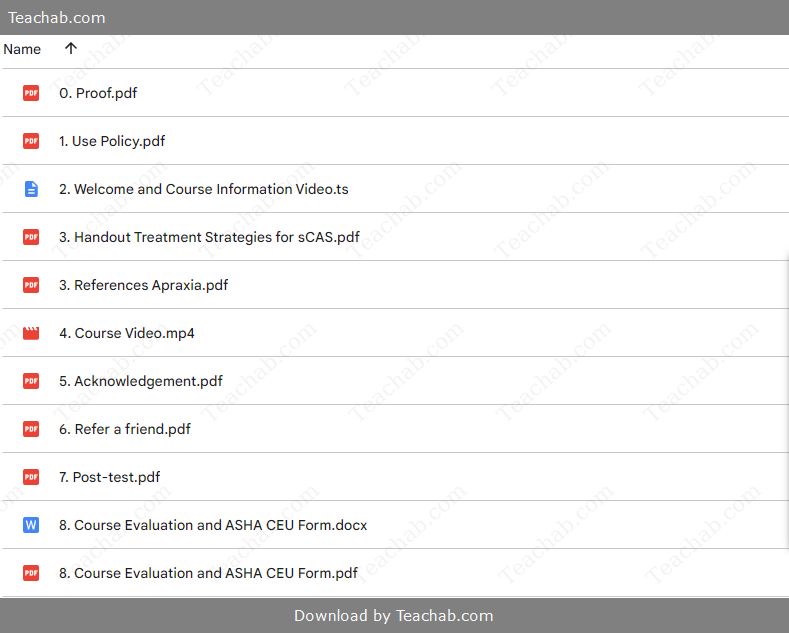Treatment Strategies for Suspected Childhood Apraxia of Speech by Cari Ebert
$50.00 Original price was: $50.00.$23.00Current price is: $23.00.
Review of Treatment Strategies for Suspected Childhood Apraxia of Speech by Cari Ebert
Content Proof:
Childhood apraxia of speech (CAS) presents unique challenges that can leave both families and professionals searching for effective strategies. In the realm of speech pathology, Cari Ebert’s course offers a beacon of hope for pediatric speech-language pathologists (SLPs) working with minimally verbal toddlers and preschoolers. By shifting the focus from traditional to innovative, evidence-based approaches, Ebert emphasizes practical, engaging therapies that resonate with both children and their families. As we delve into the treatment strategies outlined in her course, we will explore how these methods not only enhance speech development but also create a nurturing environment for both children and their caregivers.
Principles of Motor Learning
One of the foundational elements of Ebert’s approach is the principles of motor learning, which significantly reframe the treatment landscape for children with suspected CAS. Instead of adhering strictly to traditional language stimulation techniques, Ebert advocates for a model grounded in motor learning principles. This shift is akin to transitioning from abstract theory to hands-on practice in a musical education setting; one must not only learn the notes but also feel the rhythm and movement of the music to truly perform. For young children struggling with motor speech planning, understanding this principle is crucial.
Ebert delineates why motor learning is vital for enhancing speech development. Traditional methods often neglect the essential skill of motor planning which is akin to teaching someone to ride a bicycle without addressing balance or pedaling. Through a structured motor learning approach, children are provided with the tools they need to connect their thoughts to speech sounds more effectively. It is a blend of science and art, shaping the way children interact with language through purposeful engagement.
Key Components of Motor Learning
- Practicing in Context: Ebert encourages practice in situations that mirror real-life interactions, fostering natural communication rather than isolated speech exercises.
- Repetition with Variation: Engaging children in varied yet repetitive tasks can build their confidence and improve motor planning. This is reminiscent of how athletes train, combining consistency with adaptability.
- Feedback Mechanisms: Continuous, constructive feedback helps children understand their progress and adjust their strategies analogous to a sculptor refining their creation with each stroke.
By integrating these key components, Ebert’s framework positions children to thrive, transforming the complexities of CAS into manageable, purposeful steps toward mastering communication.
Motor Speech Goals
In articulating the journey toward effective communication, Ebert outlines ten motor speech planning goals specifically tailored for minimally verbal young children. These goals act as signposts on the winding road of speech development, guiding clinicians, parents, and caregivers alike toward measurable achievements.
- Sound Production: Focus on producing individual speech sounds that form the building blocks of words.
- Syllable Structures: Encourage the child to practice various syllable combinations, enhancing phonological awareness.
- Word Formation: Help the child string together sounds to form complete words, celebrating small victories along the way.
- Phrase and Sentence Building: Foster the construction of simple phrases, gradually advancing to more complex sentences.
- Communication Function: Teach the child to use their speech for different purposes, such as requesting, commenting, and greeting.
- Prosody and Rhythm: Incorporate the musicality of speech to develop a natural flow and expressiveness.
- Articulation Precision: Focus on clarity of speech sounds for better intelligibility.
- Building Vocabulary: Enrich the child’s vocabulary through exposure and repetition, engaging in meaningful interactions.
- Interactive Play: Utilize play scenarios to encourage spontaneous speech, leveraging the natural curiosity of children.
- Social Interaction: Promote conversational skills by encouraging turn-taking and theme-based discussions.
Implementation of Motor Goals
Integrating these goals into therapy not only ensures focused development but also maintains a sense of excitement and engagement factors that are particularly vital for young children. An example might be using dramatic play scenarios where children can practice speech in context, such as pretending to run a store or act like animals. This not only reinforces their language skills but also nurtures their creativity and imagination.
Play-Based Activities
Ebert’s approach places significant emphasis on play-based activities, which serve as a dynamic conduit for learning. Traditional methods often rely heavily on flashcards or repetitive drills, which may drain a child’s enthusiasm and engagement. By contrast, play-based strategies transform lessons into adventures, allowing children to practice their speech without the weight of structured learning.
Artistic Expression through Play
Incorporating play into speech therapy is like introducing colors to a black-and-white canvas it enriches the experience, making communication vibrant and relatable. Activities such as role-playing, storytelling, and interactive games provide opportunities for repetitive speech practice in an enjoyable context. The beauty of these methods lies in their flexibility; each child’s interests can guide the choice of activities, ensuring that they remain invested in their learning journey.
Types of Play-Based Activities
Here are some examples of play-based activities that Ebert recommends:
- Animal Sounds Games: Encourage children to make and repeat animal sounds, bridging motor skills with auditory processing.
- Storytelling with Puppets: Engage children in puppet shows, allowing them to express themselves through dialogues, enhancing both their creative and communicative skills.
- Interactive Craft Projects: Create projects where children label their crafts with words they are learning, reinforcing vocabulary in a hands-on manner.
By offering a plethora of play-based scenarios, Ebert effectively cultivates an environment of exploration one where young learners can practice their speech goals in context. This not only helps them to develop their communication skills but also fosters a positive attitude toward learning.
Family Involvement
Central to Ebert’s philosophy is the involvement of families in the treatment process. This approach recognizes that parents and caregivers play a crucial role in their child’s journey toward effective communication. Ebert encourages active participation from families, positioning them as partners in therapy rather than passive observers.
The Power of Collaboration
Collaboration between therapists, children, and families creates a triad of support essential for enduring success. Parents often understand their child’s unique expressions, preferences, and challenges better than anyone else; their insights can shape effective treatment strategies. By fostering open communication and providing parents with tools and techniques, therapy can extend beyond session boundaries, ensuring consistent practice in everyday contexts.
Strategies for Family Engagement
- Education and Training: Conduct workshops for parents to deepen their understanding of CAS and the necessary strategies to implement at home.
- Home Activities: Provide families with a menu of suggested activities to encourage speech practice in the comfort of their own homes.
- Encouraging Communication: Train parents to create opportunities for their children to use speech in natural settings, reinforcing learned skills through daily interactions.
Through these collaborative efforts, Ebert creates a strong support system that not only facilitates speech development but also strengthens family bonds by encouraging shared educational experiences.
Assessment and Differential Diagnosis
Ebert’s comprehensive course also addresses the importance of assessment and differential diagnosis in developing individualized interventions. For effective treatment, it is crucial to establish a clear understanding of each child’s specific challenges and strengths.
The Assessment Process
Ebert outlines a systematic approach for assessing speech that includes:
- Initial Screening: Conducting screenings to identify potential speech challenges early on.
- Detailed Evaluations: Utilizing standardized assessments to determine individual speech and language abilities.
- Continuous Monitoring: Implementing ongoing evaluations to track progress, enabling timely adjustments to treatment strategies.
This structured assessment allows therapists to differentiate between childhood apraxia of speech and other speech sound disorders, ensuring that interventions are tailored and effective. Think of it as navigating a forest; understanding the unique path of each child helps ensure they reach their destination without getting lost in a sea of one-size-fits-all solutions.
Building a Framework for Intervention
With robust assessments in place, Ebert champions the creation of a precise treatment plan that addresses the specific motor planning needs of each child. By defining clear and measurable goals, therapists can tailor interventions that speak to the child’s strengths and interests. This personalized framework transforms therapy from a daunting task into a meaningful exploration of communication.
Conclusion
Cari Ebert’s treatment strategies for suspected childhood apraxia of speech offer a refreshing, multifaceted approach to speech therapy that bridges science and creativity. By embracing principles of motor learning, establishing clear motor speech goals, integrating play-based activities, involving families, and implementing comprehensive assessments, Ebert equips pediatric speech-language pathologists with the tools necessary to foster effective communication in young children. Her emphasis on a tailored, engaging, and collaborative approach ensures that therapy is not only effective but also enjoyable. As families partner with therapists on this journey, they transform the daunting challenge of CAS into a shared adventure filled with progress, discovery, and joy.
Frequently Asked Questions:
Business Model Innovation: We use a group buying strategy that enables participants to share costs and access popular courses at lower prices. This approach helps individuals with limited financial resources, although it may raise concerns among content creators regarding distribution methods.
Legal Considerations: Our operations navigate complex legal issues. While we do not have explicit permission from course creators to resell their content, there are no specific resale restrictions mentioned at the time of purchase. This lack of clarity allows us to offer affordable educational resources.
Quality Control: We guarantee that all course materials provided are identical to those offered directly by the creators. However, please note that we are not official providers. As a result, our services do not include:
– Live coaching calls or sessions with the course author
– Access to exclusive author-controlled groups or portals
– Membership in private forums
– Direct email support from the author or their team
Our goal is to make education more accessible by offering these courses independently, without the additional premium services available through official channels. We appreciate your understanding of our unique approach.
Be the first to review “Treatment Strategies for Suspected Childhood Apraxia of Speech by Cari Ebert” Cancel reply
You must be logged in to post a review.
Related products
Personal Development
Premium Lucid Breakthrough Program – Stefan Zugor – HowToLucid
Personal Development
Magnetic Gaze Level 1: Foundations – Fabricio Astelo – Bruno Martins – Charisma School
Personal Development
The Hero Physique – Build An Aesthetic Body Naturally – Chris Archer
Personal Development
Personal Development
VIBE – Secrets of Masculine & Charismatic Body Language – Chris Archer
Personal Development
Personal Development
Unreal Series: Multiverse Key – Talmadge Harper – Harper Healing
Hypnosis & NLP
Personal Development
Personal Development
Business
Personal Development
Unreal Series: Knowledge of Center – Talmadge Harper – Harper Healing
Personal Development



















Reviews
There are no reviews yet.